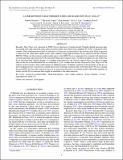| dc.contributor.author | Fender, Rob | |
| dc.contributor.author | Lee, Julia C. | |
| dc.contributor.author | Ponti, Gabriele | |
| dc.contributor.author | Tzioumis, Anastasios K. | |
| dc.contributor.author | Edwards, Philip G. | |
| dc.contributor.author | Broderick, Jess W. | |
| dc.contributor.author | Neilsen, Joseph M. G. | |
| dc.contributor.author | Coriat, Mickael | |
| dc.date.accessioned | 2015-01-16T17:02:35Z | |
| dc.date.available | 2015-01-16T17:02:35Z | |
| dc.date.issued | 2014-03 | |
| dc.date.submitted | 2013-11 | |
| dc.identifier.issn | 2041-8205 | |
| dc.identifier.issn | 2041-8213 | |
| dc.identifier.uri | http://hdl.handle.net/1721.1/92941 | |
| dc.description.abstract | Recently, Diaz Trigo et al. reported an XMM-Newton detection of relativistically Doppler-shifted emission lines associated with steep-spectrum radio emission in the stellar-mass black hole candidate 4U 1630-47 during its 2012 outburst. They interpreted these lines as indicative of a baryonic jet launched by the accretion disk. Here we present a search for the same lines earlier in the same outburst using high-resolution X-ray spectra from the Chandra HETGS. While our observations (eight months prior to the XMM-Newton campaign) also coincide with detections of steep spectrum radio emission by the Australia Telescope Compact Array, we find no evidence for any relativistic X-ray emission lines. Indeed, despite ~5 × brighter radio emission, our Chandra spectra allow us to place an upper limit on the flux in the blueshifted Fe XXVI line that is [> over ~] 20 × weaker than the line observed by Díaz Trigo et al. We explore several scenarios that could explain our differing results, including variations in the geometry of the jet or a mass-loading process or jet baryon content that evolves with the accretion state of the black hole. We also consider the possibility that the radio emission arises in an interaction between a jet and the nearby interstellar medium, in which case the X-ray emission lines might be unrelated to the radio emission. | en_US |
| dc.description.sponsorship | United States. National Aeronautics and Space Administration (Einstein Postdoctoral Fellowship Grant PF2-130097) | en_US |
| dc.language.iso | en_US | |
| dc.publisher | IOP Publishing | en_US |
| dc.relation.isversionof | http://dx.doi.org/10.1088/2041-8205/784/1/l5 | en_US |
| dc.rights | Article is made available in accordance with the publisher's policy and may be subject to US copyright law. Please refer to the publisher's site for terms of use. | en_US |
| dc.source | American Astronomical Society | en_US |
| dc.title | A LINK BETWEEN X-RAY EMISSION LINES AND RADIO JETS IN 4U 1630-47? | en_US |
| dc.type | Article | en_US |
| dc.identifier.citation | Neilsen, Joseph, Mickael Coriat, Rob Fender, Julia C. Lee, Gabriele Ponti, Anastasios K. Tzioumis, Philip G. Edwards, and Jess W. Broderick. “A LINK BETWEEN X-RAY EMISSION LINES AND RADIO JETS IN 4U 1630-47?” The Astrophysical Journal 784, no. 1 (March 4, 2014): L5. © 2014 The American Astronomical Society | en_US |
| dc.contributor.department | MIT Kavli Institute for Astrophysics and Space Research | en_US |
| dc.contributor.mitauthor | Neilsen, Joseph M. G. | en_US |
| dc.relation.journal | The Astrophysical Journal. Letters | en_US |
| dc.eprint.version | Final published version | en_US |
| dc.type.uri | http://purl.org/eprint/type/JournalArticle | en_US |
| eprint.status | http://purl.org/eprint/status/PeerReviewed | en_US |
| dspace.orderedauthors | Neilsen, Joseph; Coriat, Mickael; Fender, Rob; Lee, Julia C.; Ponti, Gabriele; Tzioumis, Anastasios K.; Edwards, Philip G.; Broderick, Jess W. | en_US |
| dspace.mitauthor.error | true | |
| mit.license | PUBLISHER_POLICY | en_US |
| mit.metadata.status | Complete | |
